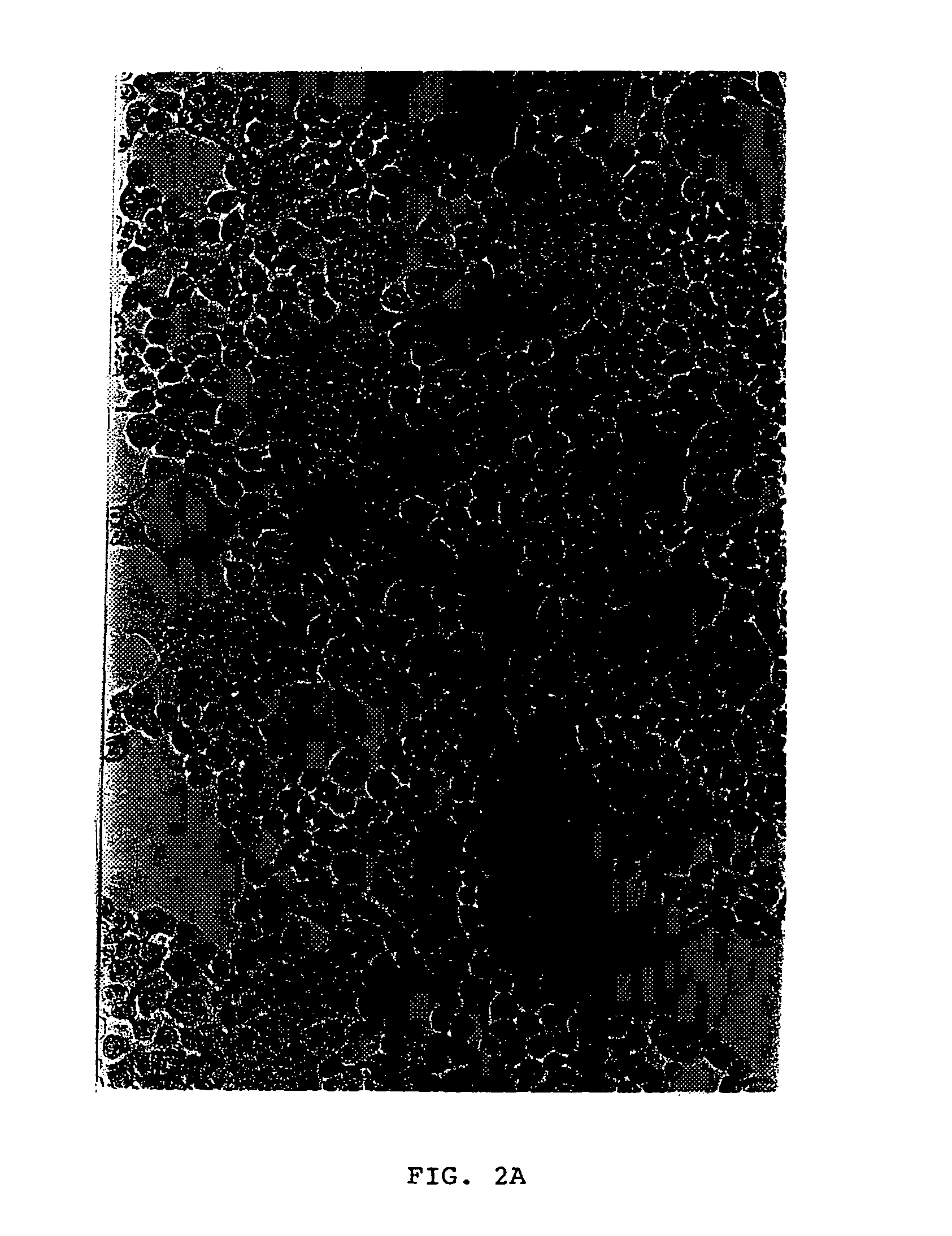Pseudotyped retroviruses and stable cell lines for their production
a cell line and pseudotype technology, applied in the field of cells, can solve the problems of inability to produce pseudotyped retroviruses stably, inability to produce at a high titer, and inability to produce cells for a limited tim
- Summary
- Abstract
- Description
- Claims
- Application Information
AI Technical Summary
Benefits of technology
Problems solved by technology
Method used
Image
Examples
example 1
Cells and Cell Culture
[0082]E86nlslacZ cells, Baby Hamster Kidney (BHK) cells, and mouse NIH3T3 fibroblasts were grown in Dulbecco's Modified Eagle Media (D-MEM, Sigma) with 10% Calf Serum (Gibco-BRL), 0.1 mg / ml streptomycin (Sigma) and 10 U / ml penicillin (Sigma)(D-MEM CS / PS). E86nlslacZ cells are NIH 3T3 cells that express MMLV capsid proteins, produced as known in the art and as described in Taylor, G. M. and Sanders, D. A. (1999) Mol. Biol. of the Cell (1999), in press, were constructed by stably transfecting GP+E86 cells of Markowitz et al. (1988) J. of Virol. 62:1120–1124 with MFG.S-nlslacZ. MFG.S-nlsLacZ is a retroviral vector encoding a nuclear localized β-galactosidase activity, produced as known in the art and as described in Ory, et al. (1996) PNAS USA 93:11400–11406.
[0083]Human HeLa, ΦNX cells, gpGFP and gpnlslacZ cells were grown in D-MEM FBS / PS). ΦNX packaging cells are second generation human embryonic kidney 293T cells transfected with MMLV gag and pol genes as descri...
example 2
Generation of Cell Lines Transiently Producing RRV-MMLV Pseudotyped Retrovirus
RRV Glycoprotein Expression Plasmid Construction
[0086]The region encoding the Ross River virus envelope glycoproteins was amplified from pRR64, a plasmid which contains the full-length Ross River viral genome [full-length sequence described in Faragher et al., (1988), Virology 163:509–526] as described in Kuhn et al. (1991), Virology 182:430–41, by the polymerase chain reaction using Pfu polymerase and two primers complementary to the viral genome at nucleotides 8375–8386 (5′-CGGGATCCACCATGTCTGCCGCGCT-3′) (SEQ ID NO:7) and 11312–11330 (5′-CGCTCTAGATTACCGACGCATTGTTATG-3′) (SEQ ID NO:8) [the amplified sequences from plasmid pRR64 are shown in (SEQ ID NO:1) beginning at nucleotide 3, and an additional “at” sequence (nucleotides 1 and 2 of (SEQ ID NO:1)) was added at the 5′ end of the pRR64 sequence]. The amplified fragment, which contained the RRV E3-E2-6K-E1 coding region, was digested with the restriction e...
example 3
Generation of Stable Cell Lines Producing RRV-MMLV Pseudotyped Retrovirus
Stable Transfection Procedure
[0091]0.5×106 ΦNX or gpnlslacZ cells were transfected following the protocol in Example 2, except that the DNA that was transferred was only 8 μg of pRRV-E2-E, and 0.4 μg of plasmid pJ6 Ωpuro coding for puromycin resistance [Morgenstern and Land, Nucleic Acids Res. 18, 1068 (1990)] and the DNA mixture contained 48 μl lipofectAMINE™ and 600 μl Optim-MEM. Selection with medium containing 2 μg / mL puromycin began at 48 hours post-transformation. Clonal colonies of cells were isolated after two weeks of selection. The resulting cell lines derived from the ΦNX cells were designated SafeRR and the resulting cell lines derived from the gpnlslacZ cells were designated SafeRRnlslacZ.
[0092]Titer was measured by infection of NIH3T3 cells as described below. Infection occurred in the presence of 8 μg / ml polybrene and infectious supernatant was changed to media without polybrene 5 hours post-infe...
PUM
| Property | Measurement | Unit |
|---|---|---|
| Fluorescence | aaaaa | aaaaa |
Abstract
Description
Claims
Application Information
 Login to View More
Login to View More - R&D
- Intellectual Property
- Life Sciences
- Materials
- Tech Scout
- Unparalleled Data Quality
- Higher Quality Content
- 60% Fewer Hallucinations
Browse by: Latest US Patents, China's latest patents, Technical Efficacy Thesaurus, Application Domain, Technology Topic, Popular Technical Reports.
© 2025 PatSnap. All rights reserved.Legal|Privacy policy|Modern Slavery Act Transparency Statement|Sitemap|About US| Contact US: help@patsnap.com



